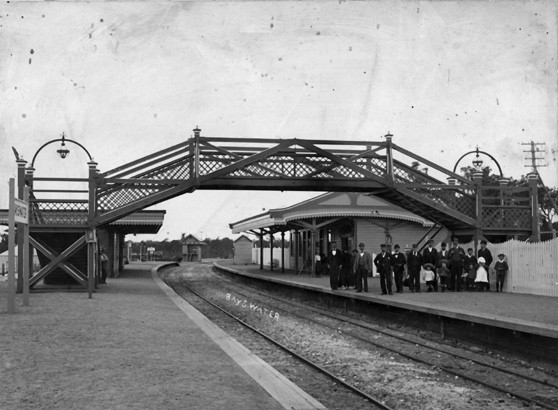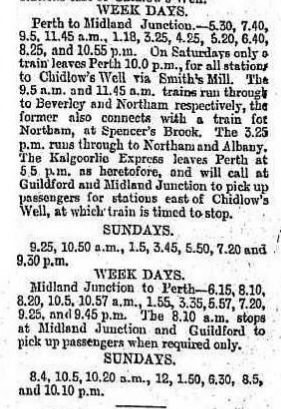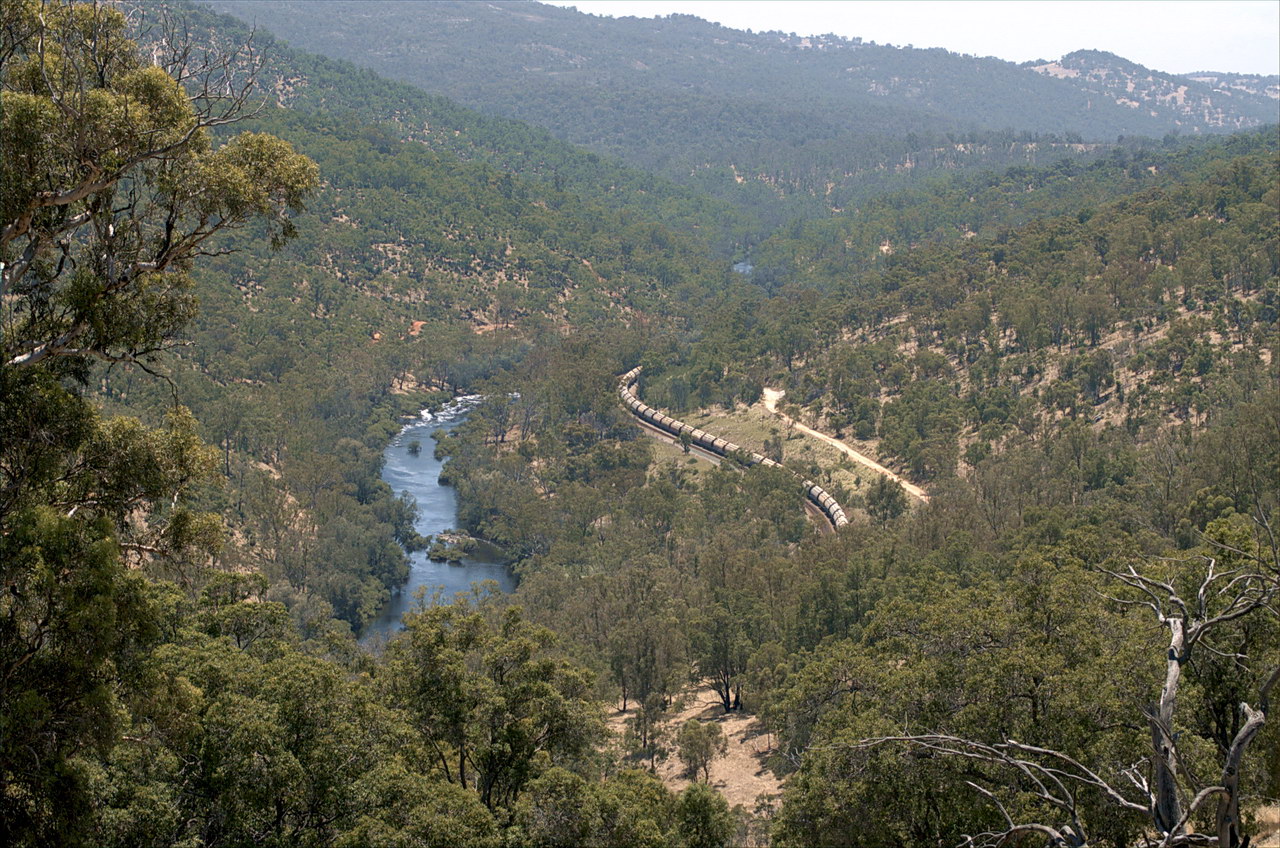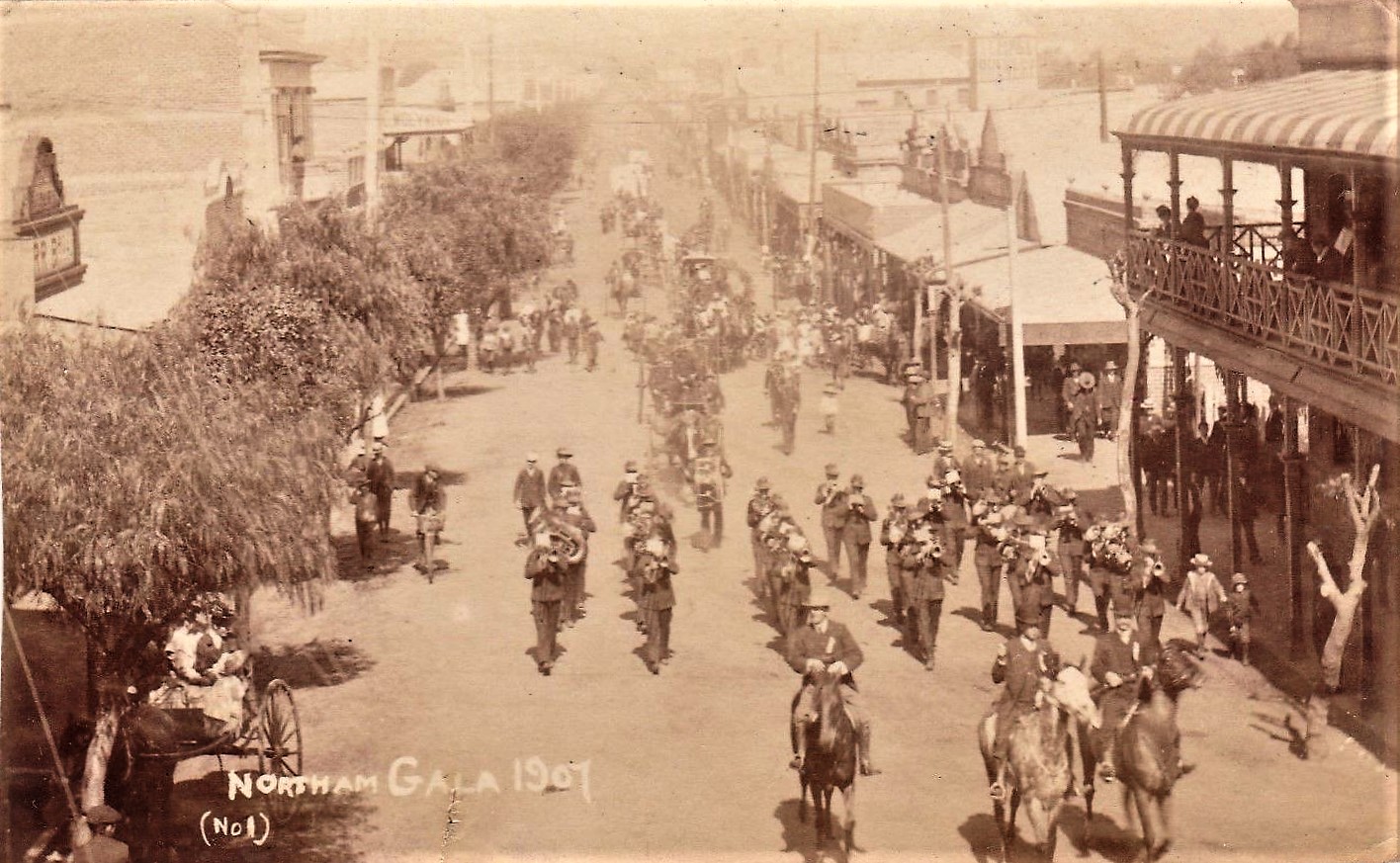Back to Adventurous Alice Part Three
Continue to Alice’s Train Journey Part Two
Skip forward to Adventurous Alice Part Four – A Single Young Woman in Kalgoorlie

Bayswater railway station, c. 1900. It must have looked much like this when Alice’s train stopped there early in her journey to Kalgoorlie. Public Domain. Original held by State Library of Western Australia via https://commons.wikimedia.org/wiki/File:Bayswater_railway_station,_c._1900.jpg
In May 1897, Alice’s contracted year of employment was over and she was free to follow whatever life path she chose. Looking at her fellow passengers, at this point they scattered far and wide. Some married, some headed for the eastern states, some stayed near Perth or Fremantle as single employed women. Some returned to England and at least two seem to have headed to the United States. But a surprising number of them went to Kalgoorlie.
By 1897 the big gold boom was at its height. Men were flocking to the Western Australian inland to stake a claim on a gold mine and make a fortune. Gold actually was being discovered, enough of it that confidence remained high. A couple of very big mining operations were underway. Little camp towns were rapidly turning into major business centres.
Hastily erected huts were being replaced by large stone buildings. Miners who were not making it rich – as yet – found work as labourers on the many constructions. The train line was opened from from Perth to Coolgardie in 1896 and that town became a city almost overnight. Inns and boarding houses thrived. Built of bluestone with high ceilings and grand entrance foyers, the boarding houses were cool in the heat and built with an elegance we don’t see today. They contained expansive sleeping quarters and large dining areas.
Obviously, domestic staff were required and the business proprietors could pay top dollar. It isn’t referenced in the history books much, but single women like Alice were also flocking to the gold fields to make their fortunes.
The whole enterprise of gold mining may have sparked Alice’s imagination. Like all other entry points to Western Australia, Fremantle was full of prospective miners heading for the goldfields. It would have been a heady dose of optimism after the gloomy and economically depressed London she had left behind.
Did they respond to an advertisement? Was it word of mouth that there was a lot of work there?

Railway line from Perth to Northam in 1897, an approximation based on newspaper references to the journey.
Railway travel was an adventure in itself in 1890s Western Australia, particularly those long rail lines into the outback. The papers of that decade are full of stories and complaints.
In 1891, the decision had been made to create a rail line to the goldfields. Competition was fierce between York and Northam to be the ‘starting point’ for the rail journey. Northam won. The line from Northam to Merredin was completed the following year, was extended to Southern Cross in 1894, then to Coolgardie in 1895 and finally to Kalgoorlie in September 1896. It was a brand new track, still full of mishaps and confusions.
At the time that Alice made this trip, there were two different lines involved. Passengers caught a train to Northam. The goldfields train began at Northam and was an entirely separate track. By the end of 1897 the first direct train from Perth to Kalgoorlie was running, but Alice probably travelled a few months too soon to catch this one. There was a ‘Kalgoorlie Express’ train but before July 1897 it followed the same track as the others and if caught behind a slow train it had to sit at that slow pace. It was ‘express’ only in that it stopped at fewer stations.

Train timetable Perth to Midland Junction April 1897 “Advertising” The Daily News (Perth, WA : 1882 – 1950) 5 April 1897: 4. Web. 22 Apr 2018 .
Everyone who wrote about these trains agreed on a couple of points. They were slow – often running hours if not days behind schedule. They were crowded. There is one reference in late 1897 to a train of eighteen passenger carriages full of people arriving in Kalgoorlie. They were unreliable. Water was a huge issue for the train which ran on steam. If at any point water was not to be had, the train had to wait for water to be brought from a nearby place.

This image is from Queensland, but shows the process involved and the style of carriage in use when Alice made her journey. https://commons.wikimedia.org/wiki/File:Watering_a_steam_train_on_the_Western_Railway_Line,_Queensland,_1890-1900_(4732501438).jpg held By State Library of Queensland, Australia [No restrictions], via Wikimedia Commons
A very very long speech was given by the Commissioner for Railways, Mr Piesse, at a Railway Picnic in May 1897. It must have taken him half an hour to give it. But he did give some useful details for the family historian of a century later.
There was hardly any necessity for saying much in order to demonstrate the advance which the Western Australian Government railways had made during the past five years, but as he had in his possession a few figures which would tell their own tale, he thought he might claim their indulgence while he submitted them … The duplication of
the line from Fremantle to Midland Junction had been in hand for some time, and the work, he was happy to say, was rapidly approaching completion. Already 19 miles had been duplicated, and before long he hoped to see the full 24 miles furnished not only with a double set of rails but also with efficient signalling and interlocking apparatus… some people had stigmatised our trains as being too slow for funerals. Well, he noticed that the other colonies had funeral railways, just the same as Western Australian had … The speed averaged in Western Australia was 16.5 miles per hour … Therefore, considering the width of gauge here as compared with those in the other colonies, and the fact that the colony had been only five years under responsible government, he thought that Western Australia could justly be proud of holding the second place in Australasia in the matter of speed of her railway trains. (1)
Passengers brought pillows and blankets for the journey, since the carriages were not heated and only first class was cushioned. There is no indication of sleeper carriages, despite the journey being an overnight trip and up to two days long in the event of track issues. Alice, Florrie and the others probably boarded at 5.50pm as per the above schedule, settled themselves into their seats and waited for luggage to be loaded and for the conductor to blow his whistle to start them on their journey.
I love railway journeys, so I spent some time researching this one.
The first part would have been exciting. Journeys always are at the start, but the line from Perth to Northam meandered greatly, following tracks laid down over a decade earlier to service what by 1897 were Perth suburbs.
1896: Rising early in the morning of September 7, we packed up a clean shirt, a piece of soap, and a toothbrush, and bustled to the central railway station. There we arrived in time to witness a typical station scene before the departure of the long-distance train. Among the ladies there was a large amount of flutter and genteel squabbling over the berths to which they were entitled, and we felt indeed sorry for Mr. John Davies, the general manager, who, however, fixed matters with tact, and managed to please everyone, even the much distressed ladies. (2)
After leaving Perth it ran northeast through Bayswater (the picture at the start of this blog post). By the 1890s the region was well settled. They would have passed through streets of houses with a few paddocks attached, past a lot of new buildings and trees. After Bayswater the line crossed the Swan River and reached Guildford, then it was just a short distance to Midland Junction where it stopped to pick up more passengers.
Midland Junction

Midland Junction Railway Station, Western Australia, May 1927. W.E. Fretwell Collection Photographs of William Edward Fretwell (1874 – 1958)
Feb 1897: Sir,- Permit me through the column of your widely-circulated journal, to draw attention to the disgraceful way in which the so called Perth-Midland Junction timetable is adhered to; or rather, is not adhered to. For the advertised 8.35 business train from Guildford to Perth to run to time is now, if not a thing of the past, a very rare exception to the rule. It is in most cases from 10 to 15 minutes and very often as much 25 minutes late . If it is found that the return journey cannot be accomplished within the advertised time, why not run the 7.45 train out from Perth ten or 15 minutes earlier? Surely this could be managed, now that the duplicate rails extend to within a mile of Guildford, without any danger of collisions.
-Tours, &c, TRAVELLER.
Guildford, February (3)
After Midland Junction, the train apparently went to Mundaring – a deviation from the present route. After Mundaring the line turned northwards and they followed the Avon River for roughly 40 miles (64km) to Toodyay. This was a very picturesque journey.

Grain train on the Eastern Railway, Western Australia alongside the Avon River. Taken .21 January 2006 by Nachoman-au under the terms of the https://en.wikipedia.org/wiki/GNU_Free_Documentation_License Version 1.2 . No changes made.
Toodyay
1922: A three hours’ train journey through stately timber country brings the tourist to Toodyay, the centre of an old-established district and one of the earliest surveyed town sites in the State. Situated on the left bank of the Avon river and nestling amid tree covered hills, Toodyay is undoubtedly one of the most charming inland towns in W.A., and affords tourists ample proof of the wisdom of the early pioneers who, almost go years ago, determined to settle in such beautiful surroundings. The clearness of the atmosphere, due to its high position, marks the district as one of the health resorts of the State … a quaint, little old fashioned village, but with all the advantages of the new world.
The Avon River, crossed by various bridges, enhances the beauty of the valley and, here and there, are beautifully clear swimming pools … (4)
From Toodyay, the train headed directly south, even veering a little back east, till it reached Clackline.
Clackline
May 1897: Disgraceful Railway Accommodation.
“The travelling public and the residents of Newcastle and district are complaining bitterly at the accommodation the Railway authorities provide for travellers between Newcastle and Clackline. The train running between these two places is only provided with one small carriage consisting of one first and two second class compartments, giving seating accommodation to 18 persons, 6 first and 12 second class. The first class passengers are the worst treated. . They pay an increased fare for the privilege of travelling with a greater degree of comfort but, for various reasons, they have often to content themselves with the hard and uncomfortable benches of the second class compartments. One reason may be that more than the half-dozen may have purchased tickets, or it may be that some gentleman may wish to have a quiet smoke on the journey but as the compartment may contain a lady or two he must perforce abstain till Clackline is reached , or retire to the second class division in the hope, often a delusive one, that no ladies are travelling there. On every hand complaints are being made, of the general discomfort experienced by travellers and some alteration is absolutely necessary.” (5)
Uncomfortable carriages weren’t the only issue.
May 1897: A Derailed Tender. — During shunting operations at Clackline on Friday last the tender of an engine became derailed. The mishap caused a delay of two hours to the Coolgardie express. (6)
There were also delays due to special trains which were sometimes attached for officials and VIPs.
After Clackline, the tracks turned directly east. The train stopped at Spencer’s Brook where passengers from Albany met the train. Once all passengers were loaded, the train continued on. Just past Spencer’s Brook they again met the Avon River which they crossed, then travelled the last half hour to Northam, the final destination.
Northam

‘Gala in Northam, W.A. – 1907’. Public Domain. Via Flickr https://www.flickr.com/photos/hwmobs/35726165862/
At one time, Northam had been the goldfield frontier. In 1897 it hovered between an outback town and a city satellite town. Nobody could commute from Northam to Perth for work, but one could certainly make it to the city and back in a long day trip, or in an easy overnight visit. In the 1890s the town was bustling with through traffic. The railway had only reached Northam in 1886 but the place had boomed in that eleven years.
Northam was a refreshment stop, so everyone disembarked here anyway. Alice and Florrie either changed trains here, or were just stopped for an hour for a meal and to stretch their legs.
Whichever it was, from this point on they were heading into a very different country.
January 1897: Trains passing through [Northam] daily are crowded with people returning to the goldfields. (5)
1. “RAILWAY PICNIC AND SPORTS GATHERING.” The Inquirer and Commercial News (Perth, WA : 1855 – 1901) 14 May 1897: 6. Web. 22 Apr 2018 <http://nla.gov.au/nla.news-article66517915>.
2. “TO KALGOORLIE AND BACK.” The Inquirer and Commercial News (Perth, WA : 1855 – 1901) 18 September 1896: 6. Web. 29 Apr 2018 <http://nla.gov.au/nla.news-article66536817>.
3. “MIDLAND JUNCTION TRAIN SERVICE.” The West Australian (Perth, WA : 1879 – 1954) 29 December 1897: 2. Web. 18 Apr 2018 <http://nla.gov.au/nla.news-article3191225>.
4. “TOODYAY.” Toodyay Herald (WA : 1912 – 1954) 11 March 1922: 2. Web. 18 Apr 2018 <http://nla.gov.au/nla.news-article148820103>.
5. “Disgraceful Railway Accommodation.” The Northam Advertiser (WA : 1895 – 1918; 1948 – 1955) 19 May 1897: 3. Web. 22 Apr 2018 <http://nla.gov.au/nla.news-article211925214>.
6. “GENERAL NEWS.” The Inquirer and Commercial News (Perth, WA : 1855 – 1901) 14 May 1897: 7. Web. 18 Apr 2018 <http://nla.gov.au/nla.news-article66517943>.
7. “RAILWAYS.” Coolgardie Mining Review (WA : 1895 – 1897) 26 December 1896: 13. Web. 14 Apr 2018 <http://nla.gov.au/nla.news-article232726390>.
Great historic report.
This is fascinating. Great research, and well told. I sometimes drive through Spencer’s Brook, but I didn’t realize that it was once an intersection between the rail lines.